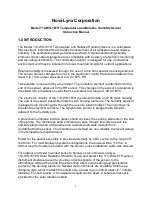
3
Table 2
Sensor Signal Wire Colors Before Splice
Wire Function
Signal Value
Wire Color
+Power
7-28 Vdc
Yellow
NOTE: These
colors are not
visible. There is an
in-line waterproof
splice.
RH Signal
0-1 Vdc
Brown
-Power
0 Vdc
Green
Temp
Therm
White
Temperature
Therm
Violet
Shield
0 Vdc
Bare
3.0 OPERATION
3.1 Relative Humidity Sensor
The relative humidity sensor in the 110-WS-16TH uses a solid state, thin film, multiple
layered device that senses relative humidity. The sensing element acts as a capacitor
that changes with respect to the vapor pressure of the air. The sensor’s capacitance
electrically changes the frequency of an electronic circuit. The sensor signal
conditioning circuitry converts the frequency change into an analog voltage. The output
signal is a linear DC voltage with a range of 0 to 1 Vdc corresponding to 0 to 100% RH.
The excitation to the RH sensor circuitry is +12 Vdc.
3.2 Temperature Sensor
The temperature probe uses a precision thermistor as its sensing element. Thermistors
are semiconductors that exhibit rapid and extremely large changes in resistance for
relatively small changes in temperature. The change in resistance is inversely































